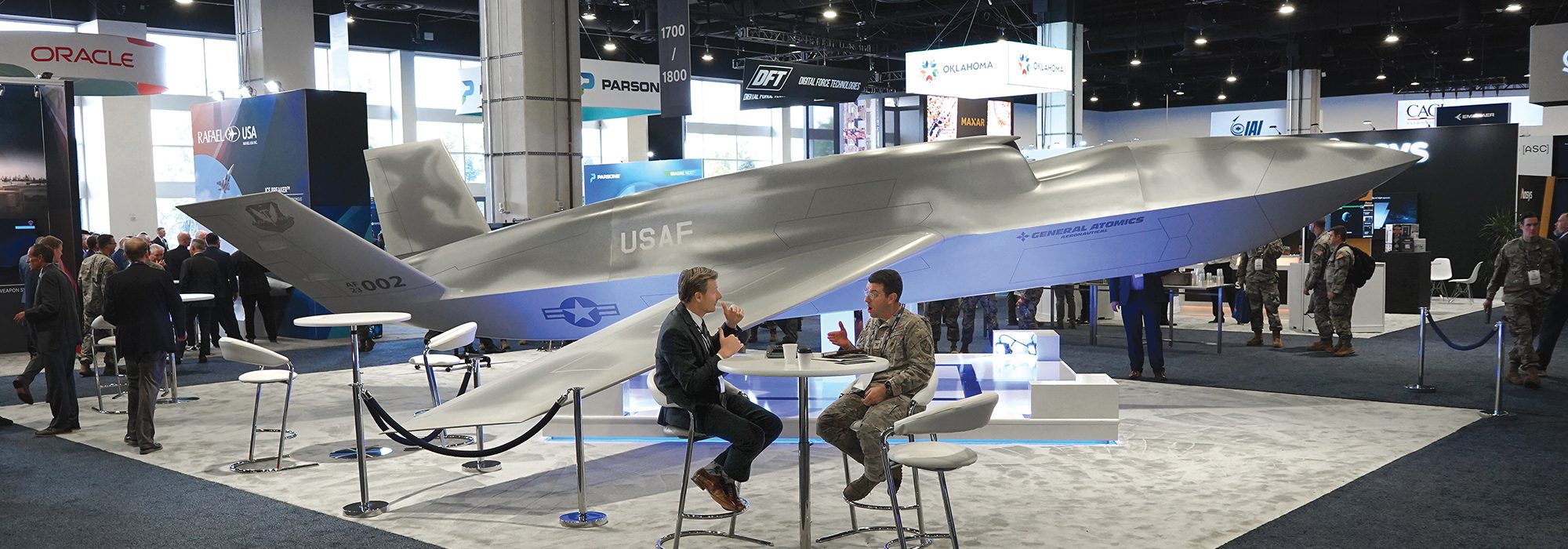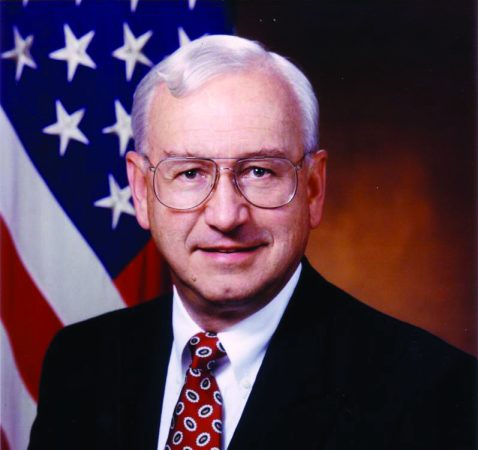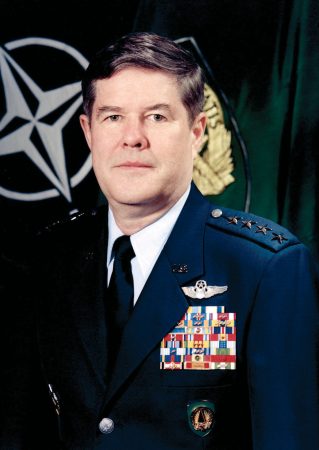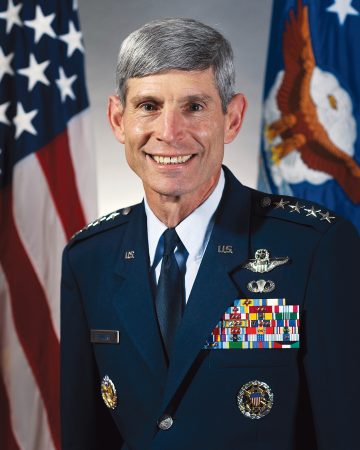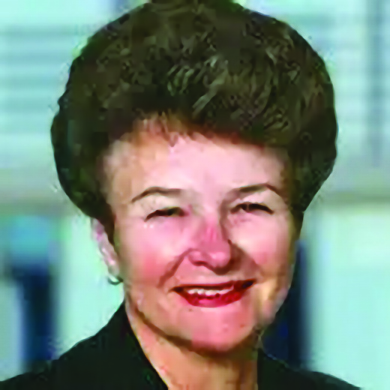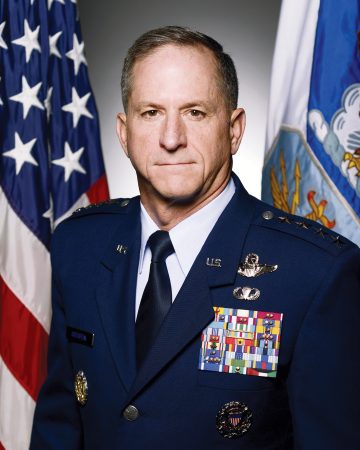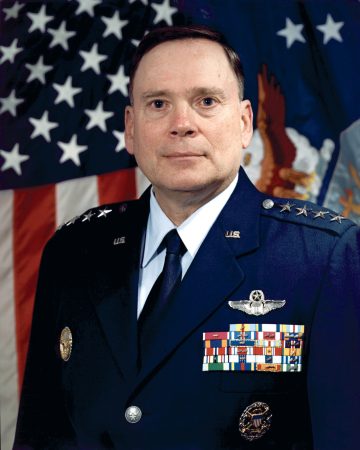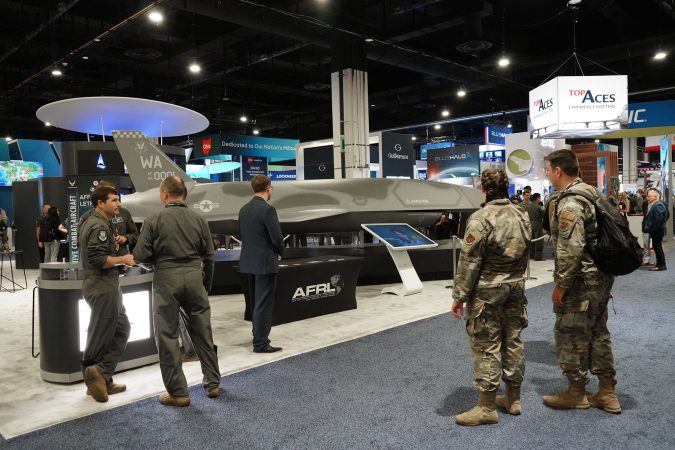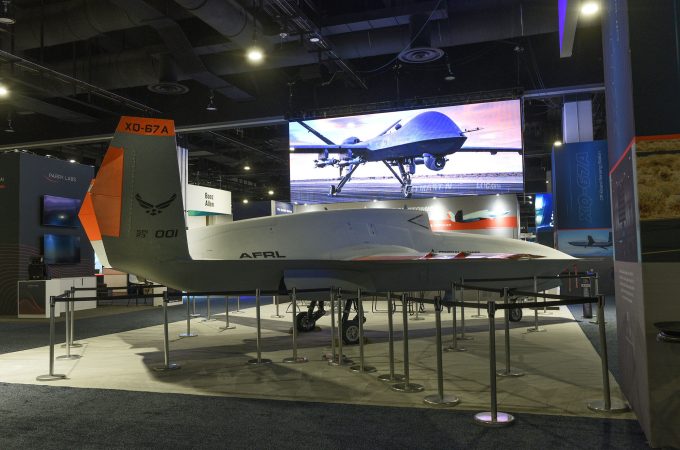NATIONAL HARBOR, Md
T
he Next-Generation Air Dominance (NGAD) combat jet—the centerpiece of the Air Force’s future air superiority plans—faces a crucial design review between now and the end of the year. What kind of aircraft the Air Force needs, what it can afford, and how long it will be before that aircraft is available all hang in the balance. The threat NGAD must defeat is evolving faster than predicted, its unit cost is extremely high—though classified, estimates near $300 million a copy—and new technologies make other approaches possible. Those factors drove Air Force Secretary Frank Kendall to “pause” the program over the summer. At AFA’s 2024 Air, Space & Cyber Conference, he explained the Air Force must now take “a very hard look at whether we’ve got the right design concept or not.”
Time is short and the stakes are very high. Seeking a clear decision in less than three months, Kendall assembled a high-level panel of experts to help with the decision:
Kendall wants a decision before the Air Force submits its fiscal 2026 budget request in December.
NGAD had been gliding toward a contractor selection in September when Kendall pressed pause. The surprise decision triggered anxious speculation: Was the Air Force abandoning the air superiority mission? Would the crewed NGAD give way to uncrewed alternatives? Kendall strenuously declared that no such fundamental changes are in play.
“We are not walking away from the core United States Air Force function of providing air superiority,” he said, repeating himself for emphasis.
The design concepts and requirements for NGAD are already “several years old,” Kendall explained, and new threats are evolving so quickly that those design requirements may now be outdated. NGAD was meant to replace the F-22 and intended “very much for a specific mission under a specific set of circumstances,” he noted, but the changing security landscape has not held steady, changing the calculus.
Because of “threat changes; because of financial constraints; because of the development of technology, including the introduction of CCAs [autonomous Collaborative Combat Aircraft],” he said, it would be imprudent to commit to a single design before reconsidering all available options.
Finances may pose the greatest hurdle. The Fiscal Responsibility Act of 2023 capped defense spending at a time when inflation had already taken a bite out of military buying power. The Air Force’s other modernization priorities—the B-21 bomber, the T-7 trainer, and the E-7 early warning aircraft—are all demanding growing budget shares. On top of that, USAF must find about $40 billion in the last half of this decade to cover mounting cost overruns on the Sentinel intercontinental ballistic missile system.
All of that argues for a less-costly answer to air superiority than one coming in at what Kendall has characterized as “multiple hundreds of millions” of dollars per copy. In engagements over the course of the week, Kendall offered a thought experiment: “Given $200 million, what would you buy: one NGAD, or one F-35 and four CCAs?”
The point was less about the specifics of the choice than an illustration of the problem: A zero-sum game in which the Air Force has to balance capability vs. affordability. What Kendall really wants is NGAD capability at a much lower cost, he told reporters.
How much lower? “We haven’t set a number or threshold,” he said, but the F-35’s $80 million-plus cost “kind of represents, to me, the upper bounds of what we’d like to pay.” Then he added, “I’d like to go lower, though.”
Cost-cutting options include building a smaller aircraft, reducing the powerplant from one engine to two, off-loading some functions to other platforms, and reducing range and payload. A smaller aircraft, though, necessitates developing a stealthy aerial tanker to escort it into contested airspace.
Functions that could be off-loaded onto CCAs that would escort the NGAD into battle include radar, weapons carriage, and electronic warfare.
The centerpiece element of the NGAD “family of systems”—a crewed fighter—could potentially be replaced with an autonomous, uncrewed aircraft. That wasn’t plausible when the prototyping phase began a decade ago, but it may be plausible now, he said.
While Kendall was clearly leaving all his options on the table, he did for the first time clearly link NGAD, the Next Generation Air-refueling System, or NGAS, and CCAs in his speech, saying the three collectively constitute the highest priority for the combat air forces.
The assessments now underway may find that NGAD must go forward as it has been structured all along, top Air Force officials acknowledged. But a senior industry official said Kendall’s talk of a jet with an F-35-like price tag “opened the door to a two-thirds cut in the cost of NGAD—I don’t see how he can walk that back.”
Whether such a price point is achievable is another question, however. The NGAD family of systems was to comprise a stealthy crewed airplane—sometimes known as the Penetrating Combat Aircraft, or PCA—along with uncrewed, autonomous CCAs and a network of airborne and space-based sensors for unprecedented situational awareness.
The CCAs are so entwined with NGAD that they share a budget line item. The Air Force has spent $4 billion on NGAD systems, including CCAs, since fiscal 2023; $3.6 billion of it on the crewed aircraft alone, not counting earlier research and development and prototyping efforts in partnership with the Defense Advanced Research Projects Agency. According to its fiscal 2025 budget request, the Air Force plans to spend $19.6 billion on NGAD and $8.9 billion on CCAs through the end of the decade.
Though highly classified, a few things are known about the program. Kendall has said he launched a technology demonstration effort for what would become NGAD while he was undersecretary of defense for acquisition, technology and logistics during the Obama administration. Those “X-plane” demonstrators have flown, most likely developed by Boeing and Lockheed Martin. Northrop Grumman CEO Kathy Warden said in July 2023 that her company wasn’t bidding on NGAD, though she indicated Northrop would compete for the Navy’s next-generation fighter, dubbed FXX. That platform has a similar mission.
Chief of Naval Operations Adm. Lisa Franchetti told reporters in October that her service is “actually in source selection right now” for its version of NGAD, the F/A-XX. Boeing, Lockheed, and Northrop are all competing for that program.
Describing the crewed NGAD options the Air Force developed, Kendall remained cagey. “It’s a fairly mature design concept,” he told reporters. “It’s classified, but it’s an F-22 replacement. You can make some inferences from that.”
CCAs Under ‘Tight Control’
Anduril Industries and General Atomics Aeronautics stole the technology show at AFA’s Air, Space & Cyber Conference, as each displayed a full-scale model of its entry for Increment 1 of the Collaborative Combat Aircraft. General Atomics went a step further, also displaying its XQ-67A demonstrator—a real “X-plane,” which flew in June, and is a close cousin to the company’s Increment 1 offering.
Autonomous CCAs could be game changers in air combat, providing added complexity to adversaries and greater flexibility and far greater numbers to USAF.
While the Air Force initially seemed to envision each crewed fighter directing three-to-five CCAs, that picture has now changed, said Air Force Secretary Frank Kendall.
“We’re talking about bigger numbers than that, now,” he said. “So, we’re moving toward greater reliance on uncrewed aircraft working with crewed platforms to achieve air superiority and to do other missions.”
If CCAs are “armed and lethal … they must be under tight control,” he said, indicating they would operate within line-of-sight communications of the crewed fighters that control them.
“I think that that’s an important thing to have in the mix: secure, reliable, line-of-sight communications,” he said. Once communications with a CCA are lost they must return to base, “which takes them out of the fight.”
Insisting on line-of-sight contact with a CCA limits how far apart a fighter and CCA could operate. But at 25,000 feet—the notional operating altitude for a CCA—that range is still significant at nearly 200 miles.
But what aircraft will control CCAs is still a “question mark,” Kendall said. The Next-Generation Air Dominance fighter might not necessarily control CCAs, he added, heightening speculation that one option is that the entire NGAD family will be uncrewed. That would suggest F-35s would take on control of CCAs.
CCA Increment 2 is also a question mark. USAF officials are still deciding whether it will be a less-sophisticated version—an “attritable” platform whose cost is low enough that losing one is acceptable—or a more exquisite version, with extremely low observability and advanced mission systems. Senior officials glibly referred to a later “Increment 3” but offered no characteristics or timetable. Some have previously said that phase could involve close allies.
John Clark, head of Lockheed Martin’s Skunk Works Advanced Development Programs division, said his company’s Increment I concept aimed too high. Lockheed offered a “gold-plated” CCA with a high degree of stealth, a stark contrast from the nonstealthy designs from Anduril and General Atomics that feature large tail fins for stability.
For Increment 2, “something that has more expendable characteristics, and is at a much, much lower cost point seems to be a good place to go explore,” Clark said at a press conference. “And so that’s where we’re exploring and putting time and energy in.” Lockheed is still waiting to see “how the Air Force is going to go with their requirements,” he added, but that “is where we think it’s going.”
However, the question is an open one, because without stealth, most CCAs “Aren’t going to make it home,” Clark said. He sees room for multiple approaches, to include survivable aircraft that “make it home every time.”
Gen. Duke Richardson, head of Air Force Materiel Command, said all of his operating centers except the Nuclear Weapons Center will have input into the development and fielding of CCAs. They include Air Force Research Labs, and the Air Force Test Center and Sustainment Center, among others. For now, the program is being managed by the Program Executive Officer for fighters and advanced aircraft, Maj. Gen. Jason Voorheis. However, with the introduction of the new Integrated Capabilities Command and the Integrated Capabilities Office, it’s still to be determined where the program will land, Richardson said.
The work of deciding what NGAD will be and the full role of CCAs is “all kind of coming together,” Kendall said. “We’re going to have, hopefully, decisions on what that package of capability is going to look like” in the near future.
The purpose of CCAs is “air superiority first and foremost,” he said. That means electronic warfare, detecting air-to-air targets and carrying air-to-air munitions.
“As we go forward, I expect there’ll be a strike aspect of CCAs as well, but initially, we’re focused on air superiority and how to use the CCAs in conjunction with the crewed aircraft to achieve air superiority,” Kendall said.
Getting a much lower price on NGAD depends on success with CCAs, Kendall said.
“Once you start integrating CCAs and transferring some mission equipment and capabilities [and] functions to the CCAs, then you can talk about a different concept” for NGAD, he said.
Industry officials pointed out, though, that at roughly $27 million or more per CCA—and, notionally, five or six of them in the NGAD formation—coupled with an $80 million crewed fighter, the overall cost for a unit of action is in the range of the crewed fighter alone. Add a stealthy tanker to the mix and the costs rise higher, with increased sustainment and personnel costs. Greater redundancy might also be necessary to ensure the mission doesn’t fail if a critical element is shot down.
Andrew Hunter, assistant secretary for acquisition and sustainment, said a lower price might be achievable if the NGAD “design concept” is revisited.
“Things that drive cost on an airplane [are] size, complexity, mission systems, [and] propulsion, which [are] related to size and complexity,” Hunter said. The combination of these factors determines overall cost.
“We want to get that right, and we’re looking for an affordable design concept,” he said.
Hunter steered clear of defining the price target, but did say the Air Force needs an aircraft it can field in volume. NGAD must be “something we can field in sufficient numbers to meet the need,” he said, suited for a “high intensity peer conflict, involving a substantial element of pace and scale and over long ranges. So that’s the puzzle we’ve got to solve. And, I grant you, it is a very challenging puzzle to solve.”
He noted the Pareto analysis—a chart which typically shows that just a few factors are responsible for most of the cost—does not settle on an obvious solution for NGAD.
“There are multiple points on that curve,” he said. It’s too soon to say whether finding a solution that costs even less than an F-35 is possible, “but we’ve got to do the work. We’ve got to do the analysis” and find out “what would be most advantageous,” Hunter said.
Does that mean NGAD is, in effect, starting over?
“It depends on what the answer is,” Hunter said. “There are different possible points of optimization. If those points are very close to where we already are, there may not need to be a huge change to our approach. If they are not close, there will have to be a significant change.”
Vice Chief of Staff Gen. James C. Slife, in a panel discussion, said the traditional ways of designing a fighter have to be set aside in view of what is now possible, particularly with regard to autonomous aircraft.
Until recently, he said, designing a fighter meant building its characteristics “around the platform—around the size of the radar you need, the range of the aircraft, how many G’s you wanted to pull. … You optimize for all of those things inside of a platform.”
But modern technology is changing that picture. “We’ve gotten to a point where, [with] our systems-level integration, we have the ability to disaggregate these capabilities and look at air superiority more broadly,” Slife said. The radar, he said, may be on one aircraft, while the munitions “may be in another location.”
If successful, that could yield “an enduring source of competitive advantage for the United States military. … A step change in American military capability.”
A decade ago, when Kendall launched what would become the GAD X-planes, there was “lengthy discussion” about whether a crewed aircraft was needed at all.
“My judgment at the time was that we weren’t quite ready to do that,” he said. He’s still not sure that time has come. “We’re probably going to do one more version, at least, of crewed, more traditional aircraft,” Kendall speculated. “I don’t know exactly what that aircraft will look like yet,” and “whether there’ll be variants that might be crewed or uncrewed is another question mark.”
That’s where Kendall’s blue-ribbon panel of experts comes into play. The group of former Air Force Chiefs and executives will be chaired by Maj. Gen. Luke Cropsey, who Kendall has also assigned to oversee and integrate the vast enterprise of its C3 Battle Management.
All the panelists have a close personal connection to stealth. Kaminski was the Pentagon’s director of low-observables technology in the 1980s when the F-117 and B-2 were being developed; Ralston was Kaminski’s military deputy and later headed the Joint Requirements Oversight Council as Vice Chairman of the Joint Chiefs of Staff. Jumper oversaw the introduction of the F-22 and learned to fly the stealth jet late in his tenure; Schwartz was involved in the force planning that led to the B-21 and NGAD; and Goldfein led the Air Force as it focused on China’s growing peer threat.
Today’s Air Force Chief of Staff, Gen. David W. Allvin, said the group’s role is to “really assess our assessments, look at the evaluations we’re doing, making sure we’re really not missing anything in our analysis, in how we understand the threat and how we understand the capabilities that are going to be required of our Air Force to meet that threat.”
Their job is not to tell the Air Force what to do, but to “give us feedback and insights … that will help us do this analysis that we have to do in fairly short order.”
The group will make recommendations to Kendall and Allvin, who “get the final say on what will be proposed” to the Office of the Secretary of Defense, and, ultimately, Congress.
Kendall said that if the NGAD as already structured turns out to be “the most cost-effective operational answer”—which he said is “still a possibility”—then, “that’s what we’re going to do.”
But that option will deliver “small numbers,” he said.
“The more the airplane costs, the … fewer you’re going to have,” he added. “Numbers do matter. So, it’s a trade-off.”
So the countdown to the decision is on. “We’ve got industry waiting for a decision. We’ve got the Congress waiting for feedback on what we expect to be done with the ’25 budget that they’re considering now, and we’re building the ’26 [Program Objective Memoranda] … for the next administration,” Kendall said. “So we’re going to move pretty quickly on this. We’ve organized that work. It’s proceeding, but it’s too early to speculate about how it’s going to come out.”
This much is clear, however: Whatever the solution, it will be expensive. “How we’re going to pay for it,” Kendall said, “at the end of the day, [may] be our biggest problem.”
